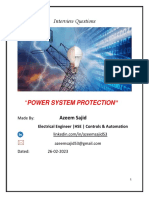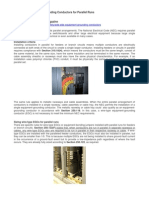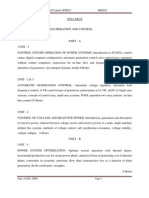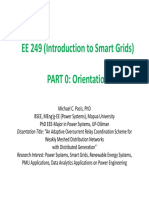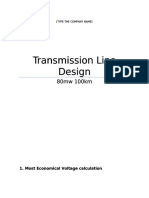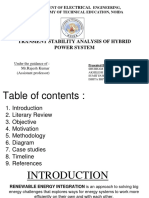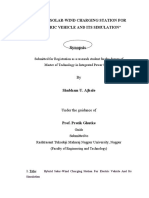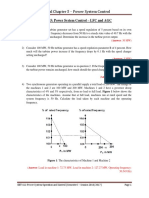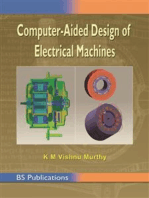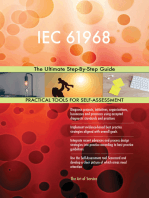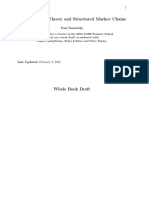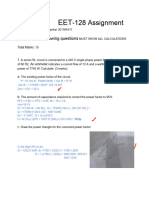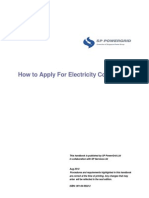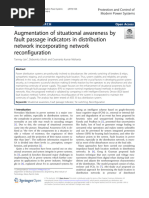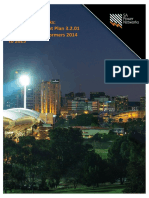Ee2303 Transmission and Distribution
Ee2303 Transmission and Distribution
Uploaded by
fpttmmCopyright:
Available Formats
Ee2303 Transmission and Distribution
Ee2303 Transmission and Distribution
Uploaded by
fpttmmOriginal Description:
Original Title
Copyright
Available Formats
Share this document
Did you find this document useful?
Is this content inappropriate?
Copyright:
Available Formats
Ee2303 Transmission and Distribution
Ee2303 Transmission and Distribution
Uploaded by
fpttmmCopyright:
Available Formats
OM SATHI
ADHIPARASAKTHI COLLEGE OF ENGINEERING
3.1 SYLLABUS EE2303 TRANSMISSION AND DISTRIBUTION 3 10 4 9
1. INTRODUCTION
Structure of electric power system - different operating voltages of generation, transmission and distribution advantage of higher operating voltage for AC transmission. An introduction to EHV AC transmission, HVDC transmission and FACTs. Mechanical design of transmission line between towers sag and tension calculations using approximate equations taking into account the effect of ice and wind. 2. TRANSMISSION LINE PARAMETERS 9
Parameters of resistance, inductance and capacitance calculations - single and three phase transmission lines - single and double circuits - solid, stranded and bundled conductors - symmetrical and unsymmetrical spacing transposition of lines concepts of GMR and GMD - skin and proximity effects - interference with neighboring communication circuits. Corona discharge characteristics critical voltage and loss. (Simple diagrams of typical towers and conductors for 400, 220 and 110 kV operations) 3. MODELLING AND PERFORMANCE OF TRANSMISSION LINES 9
Transmission line classification - short line, medium line and long line - equivalent circuits Ferranti effect - surge impedance, attenuation constant and phase constant - voltage regulation and transmission efficiency - real and reactive power flow in lines power circle diagrams shunt and series compensation. an introduction to power angle diagram - surge-impedance loading, load ability limits based on thermal loading; angle and voltage stability considerations. 4. INSULATORS AND CABLES 9
Classification of insulators for transmission and distribution purpose voltage distribution in insulator string and grading - improvement of string efficiency. Underground cables - constructional features of LT and HT cables insulation resistance, capacitance, dielectric stress and grading tan and power loss thermal characteristics. 5. SUBSTATION, GROUNDING SYSTEM AND DISTRIBUTION SYSTEM 9
Classification, functions and major components of substations. Bus-bar arrangements - substation bus schemes - single bus, double bus with double breaker, double bus with single breaker, main and transfer bus, ring bus, breaker-and-a-half with two main buses, double bus-bar with bypass isolators. Importance of earthing in a substation. Qualitative treatment to neutral grounding and earthing practices in substations. Feeders, distributors and service mains. DC distributor 2-wire and 3wire, radial and ring main distribution. AC distribution single phase and three phase 4-wire distribution. . TOTAL : 45 PERIODS 35
EE2303 TRANSMISSION AND DISTRIBUTION
OM SAKTHI
DEPARTMENT OF ELECTRICAL AND ELECTRONICS ENGINEERING
TEXT BOOKS 1. B.R.Gupta, Power System Analysis and Design, S. Chand, New Delhi, 2003. 2. S.N. Singh, Electric Power Generation, Transmission and Distribution, Prentice Hall of India Pvt. Ltd, New Delhi, 2002. REFERENCE BOOKS 1. Luces M. Fualkenberry, Walter Coffer, Electrical Power Distribution and Transmission, Pearson Education, 1996. 2. Hadi Saadat, Power System Analysis, Tata McGraw Hill Publishing Company, 2003. 3. Central Electricity Authority (CEA), Guidelines for Transmission System Planning, New Delhi. 4. Tamil Nadu Electricity Board Handbook, 2003.
3nd YEAR/ 5rd SEMESTER
OM SATHI
ADHIPARASAKTHI COLLEGE OF ENGINEERING
3.2 SHORT QUESTIONS AND ANSWERS UNIT 1 INTRODUCTION 1. Why all transmission and distribution systems are 3 phase systems? A 3 phase a.c circuit using the same size conductors as the single phase circuit can carry three times the power which can be carried by a 1 phase circuit and uses 3 conductors for the 2 phases and one conductor for the neutral. Thus a 3 phase circuit is more economical than a 1 phase circuit in terms of initial cost as well as the losses. Therefore all transmission and distribution systems are 3 phase systems. 2. Why the transmission systems are mostly overhead systems? Because of the cost consideration, the transmission systems are mostly overhead systems. 3. Why all overhead lines use ACSR conductors? ACSR conductors comprises of hard drawn aluminium wires stranded around a core of single or multiple strand galvanized steel wire. They provides the , necessary conductivity while the steel provides the necessary mechanical strength. Has less corona loss. The breaking load is high and has less weight. 4. Why transmission lines are 3 phase 3 wire circuits while distribution lines are 3 phase 4 wire circuits? A Balanced 3 phase circuit does not require the neutral conductor, as the instantaneous sum of the 3 line currents are zero. Therefore the transmission lines and feeders are 3 phase 3 wire circuits. The distributors are 3 phase 4 wire circuits because a neutral wire is necessary to supply the 1 phase loads of domestic and commercial consumers. 5. Why overhead line conductors are invariably stranded? They are stranded to make them flexible during erection and while in service. 6. State the advantages of interconnected systems. Any area fed from one generating station during overload hours can be fed from another power station and thus reserved capacity required is reduced, reliability of supply is increased and efficiency is increased. 7. What is a ring distributor? A ring distributor is a distributor which is arranged to form a closed circuit and is fed at one or more than one point. 8. State any two advantages of ring main system. 37
EE2303 TRANSMISSION AND DISTRIBUTION
OM SAKTHI
DEPARTMENT OF ELECTRICAL AND ELECTRONICS ENGINEERING
Less voltage fluctuations at consumers terminals.Less copper is required as each part of the ring carries less current than in radial system. 9. Mention the disadvantages of a 3 wire system In 3 wire system a third wire is required .The safety is partially reduced .A balancer is required and therefore cost is increased. 10. What are the advantages of a 3 wire dc distribution system over a 2 wire dc distribution system? If 3 wire system is used to transmit the same amount of power over the same distance with same efficiency with same consumer voltage we require 0.3125 times copper as required in 2 wire system. 11. State kelvins law. The annual expenditure on the variable part of the transmission system should be equal to the annual cost of energy wasted in the conductor used in that system. 12. State any two limitations of kelvins law. It is difficult to estimate accurately the annual charge on the capital outlay. It does not give the exact economical size of the conductor. 13. Define resistance of the transmission line. It is defined as the loop resistance per unit length of the line in a single phase system. In 3 phase system it is defined as the resistance per phase. 14. What are the advantages of high voltage ac transmission. The power can be generated at high voltages. The maintenance of ac substation is easy and cheaper. 15. Mention the disadvantages of high voltage ac transmission. An ac line requires more copper than a dc line. The construction of an ac line is more complicated than a dc transmission line. Due to skin effect in the ac system the effective resistance of the line is increased. 16. Mention the limitations of using very high transmission voltage. The increased cost of insulating the conductor. The increased cost of transformers ,switch gears and other terminal apparatus. 17. Mention the terminal equipments necessary in HVDC system. Converters, mercury arc valves and thyristors. Due to absence of charging currents .
3nd YEAR/ 5rd SEMESTER
OM SATHI
ADHIPARASAKTHI COLLEGE OF ENGINEERING
18. Mention the equipments that supply reactive power in HVDC converter stations ? AC filters Static shunt capacitors Synchronous condensers StaticVAR compensators . 19. Why dc transmission is economical and preferable over ac transmission for large distances only ? Because with larger distances ,the saving in cost of dc overhead lines become greater than the additional expenditure on terminal equipment . UNIT 2 TRANSMISSION LINE PARAMETERS 1.Define inductance of a line. It is defined as the loop inductance per unit length of the line .Its unit is henrys per meter. 2.Define capacitance of a line. It is defined as shunt capacitance between the two wires per unit line length. Its unit is farads per meter. 3.What is skin effect? The steady current when flowing through the conductor ,does not distribute uniformly, rather it has the tendency to concentrate near the surface of the conductor. This phenomenon is called skin effect. 4.Why skin effect is absent in dc system? The steady current when flowing through a conductor distributes itself uniformly over the whole cross section of the conductor .That is why skin effect is absent in dc system. 5.What is the effect of skin effect on the resistance of the line? Due to skin effect the effective area of cross section of the conductor through which current flow is reduced. Hence the resistance of the line is increased when ac current is flowing. 6.On what factors the skin effect depend? Nature of the material, Diameter of the wire , Frequency and shape of the wire.
7.Define symmetrical spacing. 39
EE2303 TRANSMISSION AND DISTRIBUTION
OM SAKTHI
DEPARTMENT OF ELECTRICAL AND ELECTRONICS ENGINEERING
In 3 phase system when the line conductors are equidistant from each other then it is called symmetrical spacing.
8.What is the necessity for a double circuit line? To reduce the inductance per phase and to increase the efficiency. 9.Mention the factors governing the inductance of a line. Radius of the conductor and the spacing between the conductors. 10. Define a neutral plane. It is a plane where electric field intensity and potential is zero. 11. Define proximity effect. The alternating magnetic flux in a conductor caused by the current flowing in a neighbouring conductor gives rise to a circulating current which cause an apparent increase in the resistance of the conductor .This phenomenon is called as proximity effect 12. What is the effect of proximity effect? It results in the non uniform distribution of current in the cross section, and the increase of resistance. 13. What is a composite conductor? A conductor which operates at high voltages and composed of 2 or more sub conductors and run electrically in parallel are called composite conductors. 14. What is a bundle conductor? It is a conductor made up of 2 or more sub conductors and is used as one phase conductors. 15. Mention the advantages of using bundled conductors. Reduced reactance, reduced voltage gradient , reduced corona loss .reduced Interference 16. What is meant by transposition of line conductors? Transposition means changing the positions of the three phases on the line supports twice over the total length of the line .the line conductors in practice ,are so transposed that each of the three possible arrangements of conductors exit for one-third of the total length of the line . 17. Define bundled conductors? The use of more than one conductor per phase is called bundled conductors.
3nd YEAR/ 5rd SEMESTER
OM SATHI
ADHIPARASAKTHI COLLEGE OF ENGINEERING
18. What is skin effect? The phenomenon of concentration of an ac current near the surface of the conductor is known as skin effect.
19.
On what factors does the skin effect depends?
The skin effect depends upon the 1, type of the material 2, frequency of the current 3, diameter of conductor& shape of conductor. It increases with the increase of cross-section, permeability and supply frequency. 20. Define voltage regulation.
Voltage regulation is defined as the change in voltage at the receiving (or load) end when the full-load is thrown off, the sending-end (or supply) voltage and supply frequency remaining unchanged.. % voltage regulation= ((Vs-Vr)/Vr)*100 where Vs is the voltage at the sending end Vr is the receiving end voltage. UNIT 3 MODELLING AND PERFORMANCE OF TRANSMISSION LINES 1.What is corona? The phenomenon of violet glow, hissing noise and production o overhead line is called corona. 2.Mention the factors affecting corona. Atmosphere, conductor size, spacing between conductors and line voltage. 3.Define critical disruptive voltage. It is defined as the minimum phase voltage at which corona occurs. 4.Define visual critical voltage. It is the minimum phase voltage at which corona appears all along the line conductors. 5.State any two merits of corona. Reduces the effects of transients produced by surges .System performance is improved. 6.Give the two demerits of corona. 41
EE2303 TRANSMISSION AND DISTRIBUTION
ozone gas in an
OM SAKTHI
DEPARTMENT OF ELECTRICAL AND ELECTRONICS ENGINEERING
The transmission efficiency is affected. Corrosion occurs. 7.Mention the methods of reducing corona effect. By increasing the conductor size and conductor spacing. 8.Why ACSR conductors are used in lines? If the size of the conductor is larger corona effects are reduced and reduces the proximity effect .Hence they are used in lines. 9.Define medium lines. Lines having length between 60 and 150 km and line voltages between 20 and 100kv are called medium lines. 10. Define short lines. Lines having lengths below 60km and voltages below 20kv are called short lines. 11. Mention the limitations of end condenser method. This over estimates the effects of line capacitance .It is assumed to be lumped or concentrated. 12. Explain the term voltage stability. The ability of the system to maintain the voltage level within its acceptable limits is called as voltage stability.
13. Differentiate between voltage stability and rotor angle stability. Voltage stability:
-It means load stability. -It is mainly related to reactive power transfer. -Here problems arise mainly in the event of faults. Rotor angle stability: -It means basically generator stability. -It is mainly interlinked to real power transfer. -Here problems arise during and after faults. 14. Mention the significance of Surge impedance loading. --The voltage and current are equal and are in phase at all points along the line. --No reactive power is generated or absorbed at the line ends. 15. What is shunt compensation ? Shunt compensation is the use of shunt capacitors and shunt reactors is the line to avoid voltage instability. 16. Define a synchronous compensator (condenser)?
3nd YEAR/ 5rd SEMESTER
OM SATHI
ADHIPARASAKTHI COLLEGE OF ENGINEERING
Synchronous compensator is a synchronous motor with no mechanical output .When it is under exited it operates at lagging p.f (ie it delivers vars ) .Thus it operates both as a shunt capacitor and as a shunt reactor . 17. Mention any two advantages of series compensation -improves system stability . -are generally self regulatory and requires little or no control equipment 18. Mention any two advantages of SVS .(Static Var System ) Provides fast control over temporary over voltages. Provides a better control of voltage profile . 19. State any two comparisons between series compensation and shunt compensation. -Series compensation is cheaper than SVS . -Losses are lower than in SVS . 20. Why series compensation is used in long series ? -to increase transmission capacity -to improve system stability . -to obtain correct load division between parallel circuits . UNIT 4 INSULATORS AND CABLES 1.Why cables are not used for long distance transmission? Cables are not used for long distance transmissions due to their large charging currents. 2.Mention the 3 main parts of the cable? Conductor ,dielectric ,sheath 3.What is the function of conductor? Conductor provides the conducting path for the current. 4.What is the purpose of insulation in a cable? The insulation or dielectric withstands the service voltage and isolates the conductor with other objects. 5.What is the function of sheath in a cables? The sheath does not allow the moisture to enter and protects the cable from all external influences like chemical or electrochemical attack fire etc. 43
EE2303 TRANSMISSION AND DISTRIBUTION
OM SAKTHI
DEPARTMENT OF ELECTRICAL AND ELECTRONICS ENGINEERING
6.Mention the conductor materials in cables? Copper , Aluminium 7.What is the purpose of stranding of conductors? Stranding increases the resistance of the cable .It has flexibility. 8.Define the segmental conductors. The stranded wires which are compacted by the rollers to minimize the air spaces between the individual wires are called segmented conductors .Here the conductor size is reduced for a given conductance. 9.State the properties of insulating materials. It should have high insulation resistance ,high dielectric strength ,good mechanical properties ,non-hygroscopic, capable of being operated at high temperatures ,low thermal resistance and low power factor. 10. Mention the commonly used power cables. Impregnated paper, Polyvinyl chloride, polyethene 11. Mention the advantages of pvc over paper insulated cables. Reduced cost and weight, Insulation is resistant to water, Simplified jointing, Increased flexibility No plumbing required. 12. State the merits of paper insulated cables. High current carrying capacity ,long life and greater reliability 13. State the advantages of polythene insulators. They are non-hygroscopic, light in weight, low dielectric constant, low loss factor and low thermal resistance. 14. By what materials cable sheaths are made? Lead sheaths and Aluminium sheaths. 15. In what way Al sheaths are superior to lead sheaths? Al sheaths are smaller in weight, high mechanical strength , greater conducyivity, cheap,easy to manufacture and install, withstand the required gas pressure without reinforcement. 16. Where CSA sheath is used in cables ? Corrugated seamless aluminium sheath is used in high voltage oil filled cables and telephone lines.
3nd YEAR/ 5rd SEMESTER
OM SATHI
ADHIPARASAKTHI COLLEGE OF ENGINEERING
17. Why it is used? It is used because it is very flexible and easily by repeated bending the sheath is not distorted and it is not damaged. It has lesser weight and reduced thickness. 18. Why protective covering is done in cables? To protect the cables from mechanical damage , corrosion and electrolytic action when laid direct in the ground the protective covering is made. 19. By what material protective covering is made? Bitumen &Bituminized materials, pvc and layers of fibrous materials. 20. What is meant by serving of a cable? Layers of fibrous material permitted with waterproof compound applied to the exterior of the cable is called serving of a cable. pressure cables. UNIT 5 SUBSTATION, GROUNDING SYSTEM AND DISTRIBUTION SYSTEM 1. Define sag of a line. The difference in level between the points of supports and the lowest point of the conductor is called as sag. 2.Mention the factors that affect sag in the transmission line. Weight of the conductor, length of the span , working tensile strength and the temperature. 3. What is the reason for the sag in the transmission line? While erecting the line , if the conductors are stretched too much between supports then there prevails an excessive tension on the line which may break the conductor. In order to have safe tension in the conductor a sag in the line is allowed. 4. How the capacitance effect is taken into account in a long line? They have sufficient length and operate at voltage higher than 100 kv the effects of capacitance cannot be neglected. Therefore in order to obtain reasonable accuracy in long lines , the capacitance effects are taken. 5. Mention the limitations of nominal T and pi methods in the line problems. Generally the capacitance is uniformly distributed over the entire length of the line. But for easy calculations the capacitance is concentrated at one or two points .Due to these effects there are error in the calculations. 6. What are limitations of end condenser method. 45
EE2303 TRANSMISSION AND DISTRIBUTION
OM SAKTHI
DEPARTMENT OF ELECTRICAL AND ELECTRONICS ENGINEERING
There is considerable error in calculations because the distributed capacitance has been assumed to be lumped or concentrated. This method over estimates the effects of the line capacitance.
7. What is end condenser method? It is a method used for obtaining the performance calculations of medium lines. Here the capacitance of the line is lumped or concentrated at the receiving end. 8. What is power circle diagram? It is a diagram drawm for the transmission lines network involving the generalized circuit constants and the sending end and receiving end voltage.
9. What are the voltage regulating equipments used in transmission system? Synchronous motors, tap changing transformers , series and shunt capacitors booster transformers , compound generators and induction regulator. 10. Mention the methods used for voltage control of lines Tap changing auto- transformer, booster transformer , excitation control and induction regulator. 11. What is sending end power circle diagram? The circle drawn with sending end true and reactive power as the horizontal and vertical co-ordinates are called sending end power circle diagram. 12. What is receiving end power circle diagram? The circle drawn with receiving end values are called receiving end power circle diagram. 13. what is neutral grounding. Connecting the neutral or star point of any electrical equipment(generator ,transformer etc) to earth. 14. define coefficient of earthing. =(highest rms voltage of healthy line to earth)/(line to line rms voltage) *100 to the power frequency 15. mention 2 disadvantages of ungrounded neutral occurance of insulation breakdown leading to the heavy phase to phase fault condition. -system cannot be protected from earth fault. -voltages due to lightning surges do not find path to earth. 16. Name the various types of grounding.
3nd YEAR/ 5rd SEMESTER
OM SATHI
ADHIPARASAKTHI COLLEGE OF ENGINEERING
-solid grounding -resistance grounding -reactance grounding -resonant grounding
17. give the response of resistance for earth driven rods. R=/2l *ln(4l/d) Where l length of the rod d diameter of the rod resistivity of the rod 18. for the uniformly current carrying ground driven rod , give the resistance value. R=/(2l) *(ln(8l/d) -1) Where - resistivity l length d diameter 19. define screening coefficient. Screening coefficient for n electrodes in parallel is = (resistance of one electrode)/(resistance of n electrodes in parallel * n) 20.what is a substation. The assembly of apparatus used to change some characteristic ( eg: voltage , A.C toD.C frequency power factor etc) of electric supply is called a substation.-frequency changer substation-converting substationS-industrial substation
PART B UNIT-1 1. i, compare power transmission using over head line and under ground cable. [8 MARKS] ii, Draw a simple model of UPFC ? . [8 MARKS] 2. What are the advantages of high transmission voltage for the transmission of electrical power? 3. A50KM long transmission line supplies a load of 5 MVA at 0.8 power factor lagging at 33KV.The efficiency of transmission is 90% calculate the volune of Al conductor reqired for the line when three phase 3 wire system is used .The specific resistance of AL IS 2.85*10-8 ohm-m. [16 MARKS] 4. Explain the detail types of FACTS controllers. [16 MARKS] 5. Derive expressions for sag and tension in a power conductor strung between to supports at equal highs taking into account the wind and ice loading also. [16 MARKS] 47
EE2303 TRANSMISSION AND DISTRIBUTION
OM SAKTHI
DEPARTMENT OF ELECTRICAL AND ELECTRONICS ENGINEERING
6. i) Derive the expressions for sag and conductor length under bad weather conditions. Assume Shape of overhead line is a parabola. [8 MARKS] ii) An overhead line has a span of 300m. The conductor diameter is 1.953cm and the conductor weight is 0.844kg/m. Calculate the vertical sag when a wind pressure is 736 N/sq.m of projected area acts on conductor. The breaking strength of conductor is 77990N and the conductor should not exceed half the breaking strength. [8 MARKS] 7. Draw and explain the structure of modern power systems with typical voltage levels. What is the highest VDH level available in India? [13 + 3 MARKS] 8. i) List out the main components of a HVDC system. [8 MARKS] ii) Discuss various types of HVDC links. Mentions any one HDVC link available in Indian with rating ?[8 MARKS] 9. i) Explain the different types of HVDC links and state the advantages of HVDC transmission over AC transmission. . [8 MARKS] ii) Explain why the transmission lines are 3 phase 3-wire circuits while distribution lines are 3 phase 4-wire circuits. . [8 MARKS] UNIT-2 1. From the fundamentals derive an expression for inductance of a single phase transmission system.[16 MARKS] 2. Derive expression for the inductance of three phase line with conductors untransposed .What is the significance of imaginary term in the expression for inductance ?hence derive the expression for inductance for a completely transposed line.[16 MARKS] 3. Derive for expression for the capacitance of unsymmetrical and symmetrically spaced three Phase line compare the results 4. Derive an expression for capacitances of a single phase transmission system and discuss the effect of earth on capacitance with suitable equation. [16 MARKS] 5. Derive an expression for inductance i) of a single-phase overhead line. . [8 MARKS] ii) A conductor is composed of seven identical copper strands each having a radius r. Find the Self-GMD of the conductor. . [8 MARKS] 6. i Derive an expression for the capacitance between conductors of a single-phase overhead line. [8 MARKS] ii. Find the capacitance between the conductors of a single-phase 10 km long line. The diameter of each conductor is 1.213cm. The spacing between conductors is 1.25m.Also find the capacitance of each conductor neutral. [8 MARKS] 7. Derive an expression for inductance of a 3-phase transmission line with unsymmetrical spacing? [16 MARKS] 8. Drive an expression for capacitance of a 3-phase transmission line with equilateral spacing? [16 MARKS] UNIT-3 1. Determine the efficiency and regulation of a 3phase, 100Km, 50 Hz transmission line delivering 20 MW at a power factor of 0.8 lagging and 66 kV to a balanced load. The conductors are of copper, each having resistance 0.1 O / Km, 1.5 cm outside dia, spaced equilaterally 2 metres between centres. Use nominal T method. [16 MARKS] 2. A three phase 5 km long transmission line, having resistance of 0.5 O / km and inductance of 1.76mH/km is delivering power at 0.8 pf lagging. The receiving end
3nd YEAR/ 5rd SEMESTER
OM SATHI
ADHIPARASAKTHI COLLEGE OF ENGINEERING
voltage is 32kV. If the supply end Voltage is 33 kV, 50 Hz, find line current, regulation and efficiency of the transmission line. [16 MARKS] 3. i) Show that the real power transferred is dependent on the power angle and the reactive power transferred is dependent on the voltage drop in the line. [8 MARKS] ii) The constants of a 3-phase lines are A=0.9 2? and B=140 70? O / phase. The lines delivers 60 MVA at 132 kV and 0.8 pf lagging. Draw circle diagrams and find. 4. Explain i. sending end voltage and power angle. [4 MARKS] ii. The maximum power, which the line can deliver with the above values of sending end and receiving end voltages. [4 MARKS] iii. Sending end power and power factor. [4 MARKS] iv. Line losses. [4 MARKS] 5. i) What is an equivalent ? circuit of long line? Derive expression for parameters of this circuit in terms of line parameters. [8 MARKS] ii) A 50Hz transmission line 300 km long total series impedance of 40+j25 O and total shunt admittance of 10-3 mho. The 220 Kv with 0.8 lagging power factor. Find the sending end voltage,current, power and power factor using nominal ? Method. [8 MARKS] 6. A short 3-phase transmission line has a series line impedance per phase of (20+j50) ohm. Them line delivers a load of 50 MW at 0.7 pf tag . Determine the regulation of the line and the A,B,C,D parameter of the line. If the same load is delivered at 0.7 pf load . determine the regulation of the line. system voltage 220KV? [16 MARKS] 7. The A,B,C,D constant of a 3phase transmission line are A=D=0.963+j0.016,B=33.5+j138 ohm ,C=(-0.9280+j901.223) X 10-6 mho. The load at the receiving end is 40 MW at 220 KV with power factor of 0.86 lagging .Find the magnitude of the sending and voltage ,current, power line efficiency and the voltage regulation. Assume the magnitude of the sending and voltage remains constat ? [ UNIT-4 1 Discuss any two methods to increase the value of string efficiency, with suitable sketches. 2. Explain any two methods of grading of cables with necessary diagrams. [16 MARKS] 3. i) What are different methods to improve string efficiency of an insulator? [8 MARKS] ii) In a 3-unit insulator, the joint to tower capacitance is 20% of the capacitance of each unit. By how much should the capacitance of the lowest unit be increased to get a string efficiency of 90%. The remaining two units are left unchanged. [8 MARKS] 4. i) Derive the expression for insulator resistance, capacitance and electric stress in a single core cable.Where is the stress maximum and minimum? [8 MARKS] ii) A single core 66kv cable working on 3-phase system has a conductor diameter of 2cm and sheath of inside diameter 5.3cm. If two inner sheaths are introduced in a such a way that the stress varies between the same maximum and minimum in the three layers find: 1.position of inner sheaths 2.Voltage on the linear sheaths 3.Maximum and minimum stress 5. Elaborate the various methods to improve the string efficiency? [16 MARKS] 6. What is grading of cable? Describe teo methods? [16 MARKS] UNIT-5 1. With a neat sketch explain double bus with double breaker and double bus with single 49
EE2303 TRANSMISSION AND DISTRIBUTION
OM SAKTHI
DEPARTMENT OF ELECTRICAL AND ELECTRONICS ENGINEERING
breaker. State their advantages and disadvantages. [16 MARKS] 2. Explain the following: (i) Neutral grounding (ii) Resistance grounding. [16 MARKS] 4.i)Explain different types Tariff. [8 MARKS] ii) Why a consumer having low power factor is changed at high rates. [8 MARKS] 5. Describe any four type of substation bus schemes?6 Discribe and compare the radial and ring main distribution system. What is the role of interconnectors in distribution systems? [16 MARKS]
3nd YEAR/ 5rd SEMESTER
You might also like
- Interview Questions & AnswersDocument47 pagesInterview Questions & AnswerssampathNo ratings yet
- IEEE 123 Node Test FeederDocument4 pagesIEEE 123 Node Test FeederDIEGO ALEXIS PILAGUANO AYALANo ratings yet
- ELEC9713 - 2017-Final ExamDocument6 pagesELEC9713 - 2017-Final Examsmart jamesNo ratings yet
- Intuitive Understanding of Word Embeddings - Count Vectors To Word2VecDocument34 pagesIntuitive Understanding of Word Embeddings - Count Vectors To Word2VecfpttmmNo ratings yet
- Basics of Medium-Voltage Wiring For PV Power Plant AC Collection SystemsDocument15 pagesBasics of Medium-Voltage Wiring For PV Power Plant AC Collection Systemsdanisweet100% (1)
- (Lecture# 8) SubstationDocument42 pages(Lecture# 8) SubstationTatta Maruthi100% (3)
- Components of Overhead Distribution SystemDocument9 pagesComponents of Overhead Distribution SystemReginald L. CamineroNo ratings yet
- Fundamental of Electrical Engineering SlideDocument8 pagesFundamental of Electrical Engineering SlideRexes Lim0% (2)
- HVDC TransmissionDocument14 pagesHVDC TransmissionAxay ShahNo ratings yet
- 250-122 (F) Equipment-Grounding Conductors For Parallel RunsDocument3 pages250-122 (F) Equipment-Grounding Conductors For Parallel RunsJOSE LUIS FALCON CHAVEZNo ratings yet
- Department of Mirpur Institute of TechnologyDocument40 pagesDepartment of Mirpur Institute of TechnologySEARCH GBNo ratings yet
- Question Bank (I-Scheme) : Bharati Vidyapeeth Institute of TechnologyDocument4 pagesQuestion Bank (I-Scheme) : Bharati Vidyapeeth Institute of Technology52. YASHRAJ RANSHURNo ratings yet
- Indian Power ScenarioDocument69 pagesIndian Power ScenarioManoj JhaNo ratings yet
- Types of HVDC Systems or LinksDocument7 pagesTypes of HVDC Systems or LinksGolden DaisyNo ratings yet
- Corona Effects On Ehv Ac Transmission LinesDocument5 pagesCorona Effects On Ehv Ac Transmission LinesjayanthNo ratings yet
- EE-442 (Electric Energy Utilization)Document2 pagesEE-442 (Electric Energy Utilization)dhineshkm10100% (1)
- Here: Course in Electrical Power J B Gupta PDFDocument2 pagesHere: Course in Electrical Power J B Gupta PDFAvanish NiranjanNo ratings yet
- Electric Power TransmissionDocument42 pagesElectric Power TransmissionEarl Jay UayanNo ratings yet
- Code of Practice For Storage, Installation and Maintenance of Induction MotorsDocument48 pagesCode of Practice For Storage, Installation and Maintenance of Induction MotorsKapil JoshiNo ratings yet
- Midway Report: Project Semester: Study of 220KV Substation and SLDCDocument15 pagesMidway Report: Project Semester: Study of 220KV Substation and SLDCdamanpreet singhNo ratings yet
- Sap Final ReportDocument19 pagesSap Final ReportOm BankarNo ratings yet
- Fdocuments - in 220 KV Gss Heerapura Report 558448df06729Document45 pagesFdocuments - in 220 KV Gss Heerapura Report 558448df06729Bharat Kumar PrajapatiNo ratings yet
- BEE Assignment Unit 4Document13 pagesBEE Assignment Unit 4Abhishek RaoNo ratings yet
- Eee-Viii-power System Operation and Control (06ee82) - NotesDocument138 pagesEee-Viii-power System Operation and Control (06ee82) - Noteskeerthanavijaya100% (3)
- On Gas Dielectricals-High Voltage EngineeringDocument33 pagesOn Gas Dielectricals-High Voltage EngineeringHari PrasadNo ratings yet
- Automatic Power Factor ControlDocument31 pagesAutomatic Power Factor ControlRAHUL100% (2)
- Electrical Engineering Department Electrical Installations and Drawings (ENEE323) Lecture Notes-5 Conductors, Cables and Insulating Materials CablesDocument10 pagesElectrical Engineering Department Electrical Installations and Drawings (ENEE323) Lecture Notes-5 Conductors, Cables and Insulating Materials Cablesmola znbuNo ratings yet
- Busbar TrunkingDocument9 pagesBusbar TrunkingCivilBoy BijayNo ratings yet
- EE 249 Lecture 0 Orientation PDFDocument6 pagesEE 249 Lecture 0 Orientation PDFOnofre Algara Jr.No ratings yet
- Transmission Line Design For IOE StudentsDocument20 pagesTransmission Line Design For IOE StudentsKiran PanthaNo ratings yet
- Kelvin LawDocument6 pagesKelvin LawAbdul AlimNo ratings yet
- SAP PART NewDocument16 pagesSAP PART NewKaran Babar (22EE244)No ratings yet
- Bus Bar Schemes: Submitted By: Under Guidance ofDocument26 pagesBus Bar Schemes: Submitted By: Under Guidance ofHumeraNo ratings yet
- Backward Forward Sweep Load Flow Algorithm For Radial Distribution SystemDocument3 pagesBackward Forward Sweep Load Flow Algorithm For Radial Distribution SystemtejaNo ratings yet
- SSD Unit 1Document24 pagesSSD Unit 1Shashank SinghNo ratings yet
- Questions and Answers - Sag and Tension, Vibrations and DampersDocument3 pagesQuestions and Answers - Sag and Tension, Vibrations and DampersAkd DeshmukhNo ratings yet
- Marx GeneratorDocument27 pagesMarx Generatorthakurankush9999No ratings yet
- Substation Design Chapter 18 and 19Document54 pagesSubstation Design Chapter 18 and 19Arliel John GarboNo ratings yet
- Transient Stability Analysis of Hybrid Power System: ElectricalDocument15 pagesTransient Stability Analysis of Hybrid Power System: ElectricalSumit DubeyNo ratings yet
- ANFISDocument19 pagesANFISShimaa Barakat100% (1)
- Synopsis: "Hybrid Solar-Wind Charging Station For Electric Vehicle and Its Simulation"Document9 pagesSynopsis: "Hybrid Solar-Wind Charging Station For Electric Vehicle and Its Simulation"Mahesh ShendeNo ratings yet
- Module Information Module Title Electric Drives and Control Module Code MMD2511Document4 pagesModule Information Module Title Electric Drives and Control Module Code MMD2511Ashley KaNo ratings yet
- Power Demand Calculation: 1.1. Features of FacilityDocument12 pagesPower Demand Calculation: 1.1. Features of Facilitytaochiuthuaco102No ratings yet
- Electrical Machine DesignDocument28 pagesElectrical Machine DesignsameerNo ratings yet
- Experience of Specifying and Using Reactors in A Transmission NetworkDocument8 pagesExperience of Specifying and Using Reactors in A Transmission Networkmrjack1No ratings yet
- Tutorial Chapter 5 - Power System ControlDocument2 pagesTutorial Chapter 5 - Power System ControlsahibNo ratings yet
- Exp - Machine Design LabDocument1 pageExp - Machine Design LabDineshKanawatNo ratings yet
- Protection of 3 Phase IM Against Various Abnormal Conditions Ijariie4028 PDFDocument5 pagesProtection of 3 Phase IM Against Various Abnormal Conditions Ijariie4028 PDFGanesh PawarNo ratings yet
- Upptcl Intern PDFDocument24 pagesUpptcl Intern PDFnischaljain07No ratings yet
- M.E.Electrical Power System - 2 PDFDocument32 pagesM.E.Electrical Power System - 2 PDFAnonymous 9VcxlFErfNo ratings yet
- Substation Automation Basics - The Next GenerationDocument8 pagesSubstation Automation Basics - The Next GenerationAlly RaxaNo ratings yet
- Impulse Voltage Generator Modelling Using MATLAB PDFDocument8 pagesImpulse Voltage Generator Modelling Using MATLAB PDFAsmaNo ratings yet
- PSCAD EMTDC, FuzzyControl, HVDC Transmission, VoltageDependentCurrentOrderLimit VDCOLDocument9 pagesPSCAD EMTDC, FuzzyControl, HVDC Transmission, VoltageDependentCurrentOrderLimit VDCOLKurniawan Indra LeksanaNo ratings yet
- VSC-FACTS-HVDC: Analysis, Modelling and Simulation in Power GridsFrom EverandVSC-FACTS-HVDC: Analysis, Modelling and Simulation in Power GridsNo ratings yet
- Grid-Integrated and Standalone Photovoltaic Distributed Generation Systems: Analysis, Design, and ControlFrom EverandGrid-Integrated and Standalone Photovoltaic Distributed Generation Systems: Analysis, Design, and ControlNo ratings yet
- Mathematical Model Based On The Product Sales Market Forecast of Markov Forecasting and ApplicationDocument7 pagesMathematical Model Based On The Product Sales Market Forecast of Markov Forecasting and ApplicationfpttmmNo ratings yet
- Gensim 3.0.1: Python Framework For Fast Vector Space ModellingDocument3 pagesGensim 3.0.1: Python Framework For Fast Vector Space ModellingfpttmmNo ratings yet
- How To Predict Sales Using Markov Chain - Supply Chain Link Blog - ArkievaDocument3 pagesHow To Predict Sales Using Markov Chain - Supply Chain Link Blog - ArkievafpttmmNo ratings yet
- Understanding Consumer Behavior With Recurrent Neural NetworksDocument8 pagesUnderstanding Consumer Behavior With Recurrent Neural NetworksfpttmmNo ratings yet
- An A PID Controller CVPR 2018 PaperDocument10 pagesAn A PID Controller CVPR 2018 PaperfpttmmNo ratings yet
- Statistics PDFDocument304 pagesStatistics PDFfpttmm100% (1)
- Research Discussion Paper: A Multi-Sector Model of The Australian EconomyDocument73 pagesResearch Discussion Paper: A Multi-Sector Model of The Australian EconomyfpttmmNo ratings yet
- Production Control and Demand Management in Capacitated Flow Process IndustriesDocument142 pagesProduction Control and Demand Management in Capacitated Flow Process IndustriesfpttmmNo ratings yet
- Glossary of Project Management - WikipediaDocument11 pagesGlossary of Project Management - Wikipediafpttmm100% (1)
- Prescriptive Analytics: For Business LeadersDocument97 pagesPrescriptive Analytics: For Business LeadersfpttmmNo ratings yet
- insideHPC Report Reinventing The Retail IndustryDocument9 pagesinsideHPC Report Reinventing The Retail IndustryfpttmmNo ratings yet
- Production Control and Demand Management in Capacitated Flow Process IndustriesDocument142 pagesProduction Control and Demand Management in Capacitated Flow Process IndustriesfpttmmNo ratings yet
- Bookss16 Whole Book v2Document310 pagesBookss16 Whole Book v2fpttmmNo ratings yet
- File 2.144368 001 PDFDocument108 pagesFile 2.144368 001 PDFfpttmmNo ratings yet
- Diffusion 3D PDFDocument3 pagesDiffusion 3D PDFfpttmmNo ratings yet
- Getting Started With TheanoDocument39 pagesGetting Started With TheanofpttmmNo ratings yet
- IMP GreensDocument6 pagesIMP GreensfpttmmNo ratings yet
- Kwh-Per-Capita - Electricity Consumption Per Capita - Country ComparisonDocument7 pagesKwh-Per-Capita - Electricity Consumption Per Capita - Country ComparisonfpttmmNo ratings yet
- Diffusion Gaussian Kernel PDFDocument13 pagesDiffusion Gaussian Kernel PDFfpttmmNo ratings yet
- In A of Of: Failure Transformer of LevelsDocument9 pagesIn A of Of: Failure Transformer of Levelseeng8124No ratings yet
- Gas-Insulated Switchgear For Substations: Common Characteristic Features of Switchgear InstallationDocument12 pagesGas-Insulated Switchgear For Substations: Common Characteristic Features of Switchgear Installationjoydeep_d3232No ratings yet
- EET-128 Assignment - 10177468Document4 pagesEET-128 Assignment - 10177468kugarajravi2002No ratings yet
- Procedure For Determining Short Circuit Valuecss in Secondary Electrical Distribution Efsystes PDFDocument24 pagesProcedure For Determining Short Circuit Valuecss in Secondary Electrical Distribution Efsystes PDFgirish19No ratings yet
- Energies 15 04871 v2Document19 pagesEnergies 15 04871 v2WEIWEI YANGNo ratings yet
- Introduction To Data CentresDocument62 pagesIntroduction To Data CentresRaja Kalyan100% (1)
- How To ApplyDocument129 pagesHow To ApplySasa KasaNo ratings yet
- Augmentation of Situational Awareness by Fault Passage Indicators in Distribution Network Incorporating Network ReconfigurationDocument14 pagesAugmentation of Situational Awareness by Fault Passage Indicators in Distribution Network Incorporating Network ReconfigurationJorge Ivan Silva OrtegaNo ratings yet
- EXP3 - Introduction To Substation-Edited (New)Document5 pagesEXP3 - Introduction To Substation-Edited (New)Ainur NasuhaNo ratings yet
- Voltage Regulators: Catalog InformationDocument39 pagesVoltage Regulators: Catalog Informationsincos1983No ratings yet
- Ground Fault Circuit Interrupter (GFCI) Basics - Mike Holt-EC&M MagazineDocument2 pagesGround Fault Circuit Interrupter (GFCI) Basics - Mike Holt-EC&M MagazineJOSE LUIS FALCON CHAVEZNo ratings yet
- Power System BasicsDocument4 pagesPower System BasicsAnand SundaramNo ratings yet
- ABB Electrification BIM Catalog 032022Document85 pagesABB Electrification BIM Catalog 032022j658503No ratings yet
- Feeder Protection FundamentalsDocument103 pagesFeeder Protection FundamentalsWalter CataldoNo ratings yet
- Workshop Technology NotesDocument32 pagesWorkshop Technology NotesDavid lumbasiaNo ratings yet
- AC Motor DataDocument20 pagesAC Motor DataFalak KhanNo ratings yet
- SAPN - 20.64 PUBLIC - SAPN Asset Management Plan 3.2.01 Substation Transformers 2014 To 2025 PDFDocument77 pagesSAPN - 20.64 PUBLIC - SAPN Asset Management Plan 3.2.01 Substation Transformers 2014 To 2025 PDFbhabani prasad pandaNo ratings yet
- Experiments.1 12Document95 pagesExperiments.1 12Muhammad UmairNo ratings yet
- Engr Qazi Arsalan Hamid AliDocument4 pagesEngr Qazi Arsalan Hamid AliarsalanhamidNo ratings yet
- Chint Ac Ev Charger 202404Document10 pagesChint Ac Ev Charger 202404Manoel SilvestreNo ratings yet
- A Three-Phase State Estimation in Active Distribution Networks PDFDocument9 pagesA Three-Phase State Estimation in Active Distribution Networks PDFJesus Ortiz LopezNo ratings yet
- TD Brochure LV MV HV Cable Installation Jointing Substation Electrical Equipment PDFDocument12 pagesTD Brochure LV MV HV Cable Installation Jointing Substation Electrical Equipment PDFMohammed MustafaNo ratings yet
- Subtransmission Systems: Noornabi ShaikhDocument9 pagesSubtransmission Systems: Noornabi ShaikhAwesh KumarNo ratings yet
- Acces Point - Ee Refresher 2Document12 pagesAcces Point - Ee Refresher 2christinesarah0925100% (1)
- Design Guide for Dubai - Electrical (2024)Document29 pagesDesign Guide for Dubai - Electrical (2024)ashraf atefNo ratings yet
- Manual Distribution Network Operation ManualDocument113 pagesManual Distribution Network Operation ManualJorge Cáceres0% (1)
- FPSC Assistant Executive Engineer (Electrical) 02 Aug, 2019 PDFDocument10 pagesFPSC Assistant Executive Engineer (Electrical) 02 Aug, 2019 PDFAnonymous JyKrXZDXLGNo ratings yet
